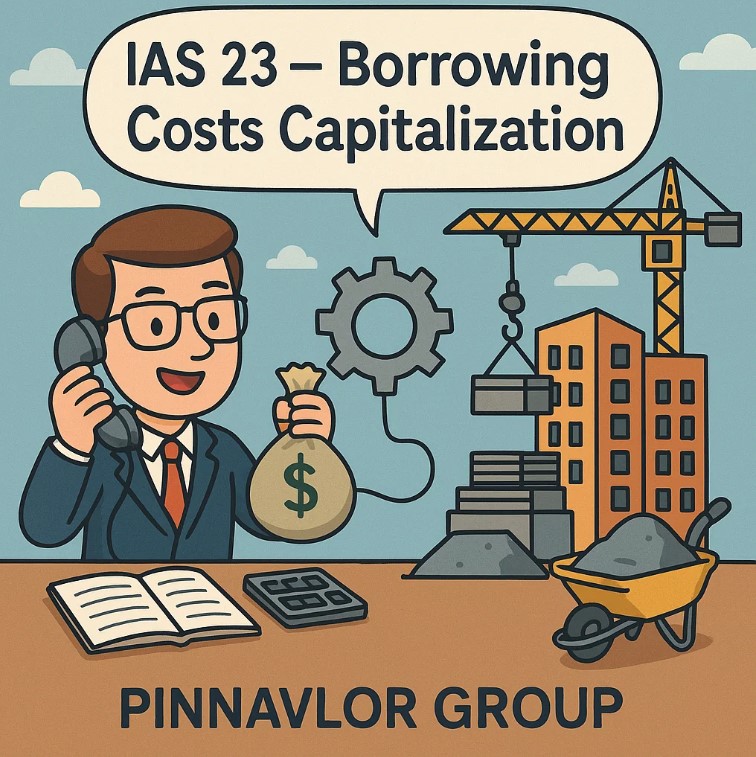
IAS 23 – Borrowing Costs Capitalization: Understanding the IFRS Approach
When constructing a large-scale project or developing a long-term asset, the interest paid on borrowings becomes a significant cost element. But does it simply go to the expense line? Not always.
IAS 23 – Borrowing Costs, an International Financial Reporting Standard issued by the IASB, answers this question by providing guidelines on when and how borrowing costs should be capitalized instead of expensed.
Did you know your loan interest could become part of your asset's value instead of an expense?
Every construction cost counts—including interest. Capitalizing borrowing costs aligns cost with asset life and future returns.
This blog explores what IAS 23 entails, when capitalization is required, and how to apply it correctly, including key examples and practical implications.
🎯 Objective of IAS 23
The objective of IAS 23 is to prescribe the accounting treatment for borrowing costs. The standard requires entities to capitalize borrowing costs that are directly attributable to the acquisition, construction, or production of a qualifying asset.
🔑 Key Definitions
Borrowing costs include:
- Interest expense (using the effective interest method)
- Finance charges on lease liabilities
- Amortization of discounts or premiums
- Foreign exchange differences (only if regarded as adjustments to interest costs)
An asset that necessarily takes a substantial period of time to get ready for its intended use or sale.
Examples include:
- Real estate developments
- Power plants
- Large-scale manufacturing plants
- Internally developed intangible assets (e.g., software)
📋 Capitalization Criteria
Borrowing costs must be capitalized when they are:
- Directly attributable to the acquisition or construction of a qualifying asset, and
- Incurred during the development phase of the asset.
🕒 When Does Capitalization Begin?
Capitalization begins when all the following conditions are met:
- Expenditures for the asset are being incurred
- Borrowing costs are being incurred
- Activities to prepare the asset for use or sale are in progress
🛑 When to Suspend Capitalization?
Capitalization must be suspended if development is interrupted for an extended period, unless the delay is necessary to the process.
✅ When to Cease Capitalization?
Borrowing costs capitalization ends when the asset is ready for its intended use or sale, even if it is not yet used or sold.

🔄 Specific vs General Borrowings
If funds are borrowed specifically for a qualifying asset, the actual borrowing cost incurred (minus investment income) is capitalized.
For general borrowings, apply a capitalization rate (weighted average of general borrowing costs) to the asset expenditure.
📌 Foreign Exchange Differences
Under IAS 23, foreign exchange differences can be treated as borrowing costs if they are adjustments to interest costs. This is optional and depends on the entity's accounting policy.
🧠 Practical Example
Scenario:
- Company A is building a power plant over 2 years.
- It borrows $5 million at 10% interest.
- Annual interest: $500,000
- If $50,000 investment income is earned, only $450,000 is capitalized.
📊 Disclosure Requirements
Entities must disclose:
- The amount of borrowing costs capitalized during the period
- The capitalization rate used
📉 Borrowing Costs to Be Expensed
Borrowing costs not directly attributable to a qualifying asset are expensed. For example:
- Working capital loans
- Overdrafts unrelated to asset construction
🔁 Comparison with Ind AS 23
| Topic | IAS 23 (IFRS) | Ind AS 23 (India) |
|---|---|---|
| FX differences as interest | Optional | Mandatory if adjustment to interest |
| Inventory capitalization | Optional | Mandatory |
| Policy flexibility | Higher | Lower |
💡 Key Takeaways
- Capitalize borrowing costs only for qualifying assets.
- Meet all three capitalization conditions before beginning.
- Optional treatment of FX differences offers flexibility.
📝 Final Thoughts
IAS 23 ensures that the true cost of building long-term assets is reflected in financial statements. Proper application provides a clear and fair financial picture for users of financial statements.
Whether you're a CFO, auditor, or student, understanding IAS 23 is essential for complying with IFRS and improving financial transparency.
